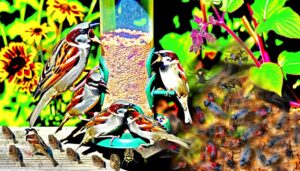House Sparrow vs. Robin – 5 Key Size Differences
The house sparrow (Passer domesticus) measures 14-16 cm in length with a wingspan of 19-25 cm, characterized by a compact and robust body. In contrast, the American robin (Turdus migratorius) spans 23-28 cm in length and exhibits a wingspan of 31-41 cm, reflecting its elongated and streamlined physique.
Sparrows typically weigh 24-39 grams, whereas robins weigh between 77-85 grams. These differences influence their flight patterns, with sparrows excelling in agile maneuvers in dense foliage and robins capable of robust, sustained flights in open spaces.
Explore further to discover their unique behavioral adaptations and habitat preferences.

Key Takeaways
- House sparrow is 14-16 cm long, while the American robin is 23-28 cm long.
- House sparrow's wingspan is 19-25 cm; American robin's wingspan is 31-41 cm.
- House sparrow weighs 24-39 grams; American robin weighs 77-85 grams.
- House sparrows have agile, rapid flight; robins have sustained, gliding flight.
- House sparrows prefer urban areas; robins prefer rural environments.
Physical Dimensions
How do the physical dimensions of the house sparrow (Passer domesticus) compare to those of the American robin (Turdus migratorius)?
The house sparrow typically measures 14-16 cm in length with a wingspan ranging from 19-25 cm.
In contrast, the American robin is considerably larger, measuring 23-28 cm in length and boasting a wingspan of 31-41 cm.
Morphologically, the house sparrow exhibits a more compact and robust body structure, whereas the American robin has a more elongated and streamlined physique.
Behavioral observations indicate that the house sparrow's smaller size allows for agile maneuvering in dense foliage, while the American robin's larger dimensions facilitate more robust flight patterns and foraging behaviors in open spaces.
Weight Comparison
When examining the weight of these two bird species, the house sparrow typically weighs between 24-39 grams, whereas the American robin is noticeably heavier, with a weight range of 77-85 grams.
This considerable disparity in mass is primarily attributed to the ecological niches and dietary habits of each species. House sparrows, which are granivorous, tend to have a lighter body mass suited for their foraging lifestyle. Conversely, the American robin's omnivorous diet, consisting of fruits and invertebrates, supports a larger body size.
This difference in weight is not merely a statistic but influences their respective behaviors, such as flight endurance and predator evasion strategies. Understanding these weight variances provides insight into their adaptive strategies and ecological roles.
Wingspan Differences
Frequently, the wingspan of the house sparrow measures around 20-25 centimeters, while the American robin boasts a more expansive wingspan ranging from 31-41 centimeters.
This notable disparity in wingspan can be attributed to several factors:
- Aerodynamics: The larger wingspan of the robin enhances its flight stability and maneuverability.
- Foraging Range: Robins, with their greater wingspan, can cover more ground while foraging compared to house sparrows.
- Migration Patterns: The robin's extended wingspan facilitates long-distance migration, unlike the more sedentary house sparrow.
- Habitat Utilization: House sparrows often inhabit urban areas with confined spaces, where a smaller wingspan is advantageous.
These measurements are essential for understanding species-specific adaptations and ecological roles.
Impact on Behavior
The difference in wingspan between the house sparrow and robin significantly influences their respective behaviors, particularly in their flight patterns, foraging strategies, and habitat preferences.
House sparrows (Passer domesticus), with an average wingspan of approximately 20-22 cm, exhibit rapid, undulating flight patterns conducive to maneuvering densely vegetated areas.
Conversely, robins (Turdus migratorius), boasting a wingspan of 31-41 cm, demonstrate more sustained, gliding flight suited for open spaces.
Foraging strategies also differ; house sparrows primarily glean food from the ground and low vegetation, while robins frequently forage on lawns, using their robust beaks to extract invertebrates.
These behavioral distinctions, driven by morphological differences, underscore the ecological niches these species occupy and their adaptability to varied environmental conditions.
Habitat Preferences
House Sparrows (Passer domesticus) and Robins (Erithacus rubecula) exhibit distinct habitat preferences, with House Sparrows mainly inhabiting urban areas, while Robins are more frequently found in rural environments.
House Sparrows select nesting sites in close proximity to human structures, favoring cavities and man-made crevices, whereas Robins typically choose natural sites such as dense foliage and tree branches.
These differing preferences influence their respective distributions and accessibility to resources.
Urban Vs. Rural Areas
Urban and rural habitats present distinct challenges and advantages that greatly influence the distribution and behavior of house sparrows and robins.
House sparrows (Passer domesticus) thrive in urban environments due to abundant food sources and nesting opportunities.
In comparison, European robins (Erithacus rubecula) prefer rural areas with dense vegetation for foraging and nesting.
Key observations include:
- Food Availability: Urban areas provide consistent human-related food sources for house sparrows, whereas robins rely on natural insect populations in rural settings.
- Predation Pressure: Urban environments may offer some protection from natural predators, benefiting house sparrows.
- Nesting Materials: The availability of nesting materials varies, influencing habitat preference.
- Noise Pollution: Urban noise can disrupt robin communication signals but has a lesser impact on house sparrows.
Nesting Site Choices
Both house sparrows and European robins exhibit distinct preferences for nesting sites, driven by their unique ecological requirements and behavioral adaptations. House sparrows (Passer domesticus) frequently select urban and suburban environments, utilizing cavities in buildings, eaves, and other structural crevices. Their nests are typically bulky, constructed from grass, feathers, and debris.
In contrast, European robins (Erithacus rubecula) favor more natural settings, such as dense shrubbery, tree hollows, and even ground-level sites. Their nests are compact and cup-shaped, meticulously built from moss, leaves, and grass. Observational data indicate robins are more territorial, often defending nesting sites within a 20-meter radius, whereas sparrows exhibit more communal nesting behavior.
These divergent nesting preferences reflect their differing survival strategies and habitat use.
Survival Strategies
Adaptations in feeding behavior and nesting site selection are critical survival strategies that enable both the house sparrow (Passer domesticus) and the robin (Erithacus rubecula) to thrive in diverse environments.
House sparrows exhibit granivorous tendencies, efficiently exploiting anthropogenic food sources. Robins, primarily insectivorous, demonstrate remarkable foraging flexibility, shifting diets seasonally.
Nesting strategies also vary notably:
- House Sparrows:
- Utilize urban structures for nesting, reducing predation risk.
- Robins:
- Prefer dense vegetation, providing camouflage and thermal insulation.
- Sparrow Nesting:
- Often in cavities, leveraging human-made structures.
- Robin Nesting:
- Construct open cup nests, facilitating quick access for feeding.
These behaviors illustrate their adaptability, ensuring survival amidst ecological pressures.
Conclusion
Despite being diminutive in stature, the house sparrow (Passer domesticus) and the robin (Erithacus rubecula) embody the quintessential struggle for avian supremacy.
The house sparrow's modest 16-22 grams and 20-22 cm wingspan are dwarfed by the robin's more robust 19-22 grams and 20-22 cm wingspan.
However, such trivial differences in mass and dimension evidently dictate complex behavioral hierarchies, habitat selections, and survival tactics, proving once again that in the grand theater of nature, size does indeed matter.






